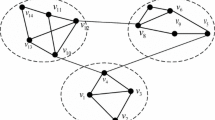Abstract
Social network detection and identification constitute an important topic in the field of sociology. Previous graph similarity has focus on either the topological structure of graph or the feature value of vertex. In this work, a multi-similarity measure method for community is described. The approach devised by using multi-similarity properties based on vertex features, relationship density and topology structure, and therefore is can be formulated and extended to practical implementation. The framework of community detection combines K-means clustering, spectral clustering and modularity algorithm-making it an effective basis for the realization of a social network interpretation. With this scheme, three evaluation criteria are proposed for methodology determination. The experimental results show a better working performance of the recommended method than traditional algorithms via statistical analysis.









Similar content being viewed by others
Explore related subjects
Discover the latest articles and news from researchers in related subjects, suggested using machine learning.References
Hechter, M.: Principles of Group Solidarity. University of California Press, Berkeley (1988)
Liu, C., Liu, J., Jiang, Z.: A multiobjective evolutionary algorithm based on similarity for community detection from signed social networks. IEEE Transact. Cybern. 44(12), 2274–2287 (2014)
Alhajj, R.: Introduction to the second issue of Social Network Analysis and Mining journal: scientific computing for social network analysis and dynamicity. Soc. Netw. Anal. Mining 1, 73–74 (2011)
Watts, D.J., Strogatz, S.H.: Collective dynamics of small-world networks. Nature 393(6638), 440–442 (1998)
Adamic, L.A., Huberman, B.A.: Power-law distribution of the world wide web. Science 287(5461), 2115 (2000)
Devinatz, V.G.: Introduction to social networking, management responsibilities, and employee rights: the evolving role of social networking in employment decisions. Empl. Responsib. Rights J. 27, 305–306 (2015)
Lee, S.-H., Kim, J.-M., Choi, Y.-K.: Similarity measure construction using fuzzy entropy and distance measure. LNAI 4114, 952–958 (2006)
Ronald, R.Y.: Monitored heavy fuzzy measures and their role in decision making under uncertainty. Fuzzy Sets Syst. 139(3), 491–513 (2003)
Rbill, Y.: Decision making over necessity measures through the Choquet integral criterion. Fuzzy Sets Syst. 157(23), 3025–3039 (2006)
Hsieh, C.H., Chen, S.H.: Similarity of generalized fuzzy numbers with graded mean integration representation. In: Proceedings of the Eighth International Fuzzy Systems Association World Congress, pp. 551–555 (1999)
Chen, S.-M., Chen, J.-H.: Fuzzy risk analysis based on similarity measures of generalized fuzzy numbers. IEEE Transact. Fuzzy Syst. 11(1), 450–56 (2003)
Tan, P.N., Steinback, M., Kumar, V.: Introduction to data mining. Data Anal. Cloud 22(6), 1–25 (2006)
Jeh, G., Widom J.: SimRank.: a measure of structural-context similarity. In: Proceedings of the eighth ACM SIGKDD International Conference on Knowledge Discovery and Data Mining. ACM, pp. 538–543 (2002)
Yu, W., Lin, X., Zhang, W., et al.: More is simpler: effectively and efficiently assessing vertexpair similarities based on hyperlinks. Proc. Vldb Endow. 7(1), 13–24 (2013)
Zhao, P., Han, J., Sun, Y.: P-Rank.: a comprehensive structural similarity measure over information networks[C]. In: Proceedings of the ACM Conference on Information and Knowledge Management, CIKM 2009, Hong Kong, China, November pp. 553–562 (2009)
Antonellis, I., Molina, H.G., Chang, C.C.: Simrank++: Query rewriting through link analysis of the click graph. Comput. Sci. 1, 1177–1178 (2007)
MacKay, D.C.: Information Theory, Inference, and Learning Algorithms. Cambridge University Press, Cambridge (2003)
Ding, S., Jia, H., Zhang, L.: Research of semi-supervised spectral clustering algorithm based on pairwise constraints. Neural Comput. Appl. 24(1), 211–219 (2014)
Nawaz, W., et al.: Intra graph clustering using collaborative similarity measure. Distrib. Parallel Databases 33(4), 583–603 (2015)
Sun, Y., Han, J., Yan, X., et al.: PathSim: meta path-based top-K similarity search in heterogeneous information networks. Proc. Vldb Endow. 4(11), 992–1003 (2011)
Qin, X., Dai, W., Jiao, P., et al.: A multi-similarity spectral clustering method for community detection in dynamic networks. Sci. Rep. 6, 31454 (2016)
Niknam, T., Amiri, B., OlamaeI, J., AREFI, A.: An efficient hybrid evolutionary optimization algorithm based on PSO and SA for clustering. J. Zhejiang Univ. 10(4), 512–519 (2009)
Page, L.: The PageRank Citation Ranking: Bringing Order to the Web, pp. 1–14. Stanford InfoLab, Stanford (1998)
Newman, M.E.J., Girvan, M.: Finding and evaluating community structure in networks. Phys. Rev. E: Stat. 69(2), 026113 (2003)
Macqueen J.: Some methods for classification and analysis of multivariate observations. In: Proceedings of the Berkeley Symposium on Mathematical Statistics and Probability, pp. 281–297 (1967)
Shi, J., Malik, J.: Normalized cuts and image segmentation. IEEE Transact. Pattern Anal. Mach. Intell. 22(8), 888–905 (2002)
Park, E.J., Dollinger, A., Huether, L., et al.: The nano-fractal structured tungsten oxides films with high thermal stability prepared by the deposition of size-selected W clusters. Appl. Phys. A 123(6), 418 (2017)
Tian, Y., Hankins, RA., Patel, JM.: Efficient aggregation for graph summarization. In: Proceedings of the ACM SIGMOD International Conference on Management of Data, pp. 567–580 (2008)
Acknowledgements
The research was partially funded by the Key Program of National Natural Science Foundation of China (Grant Nos. 61133005, 61432005), the National Natural Science Foundation of China (Grant Nos. 61370095, 61472124, 61572175), International Science & Technology Cooperation Program of China (2015DFA11240). The work was supported by research Project of the Education Department of Hunan Province (Grant No. 14c0210).
Author information
Authors and Affiliations
Corresponding author
Rights and permissions
About this article
Cite this article
Ni, L., ManMan, P., Wenjun, J. et al. A community detection algorithm based on multi-similarity method. Cluster Comput 22 (Suppl 2), 2865–2874 (2019). https://doi.org/10.1007/s10586-017-1610-0
Received:
Revised:
Accepted:
Published:
Issue Date:
DOI: https://doi.org/10.1007/s10586-017-1610-0




